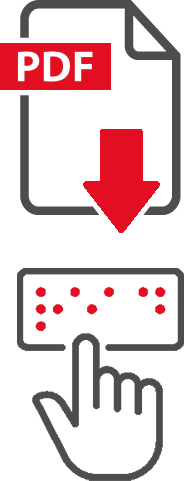Digital tagging enables PDF Accessibility
An Accessible PDF… what is it ?
For the 10% of the population who have a visual, cognitive or motor impairment in Europe, access to the content of websites can be a real challenge. How have an inclusive life without access to critical information on the internet, such as a bus schedule, a new administrative regulation, or the user instruction manual for an electronic device … The notion of PDF accessibility is at the very heart of this problem.
Numerous PDF documents circulate on the websites. As it stands, these documents are not available for all persons with visual impairments. Braille tracks or voice synthesizer, which these persons use to surf the Internet cannot interpret the particular coding of the PDF format. PDF accessibility is a digital treatment aimed precisely at tagging the document hence making it readable.
Who are the people concerned ?
According to WHO, about 1.3 billion people in the world, have some form of visual impairment. In Europe, the statistics show that almost 10% are affected. These figures include people with blindness, low vision, cognitive and motor impairments. The majority of these individuals are over 50 years old. With the growing and ageing of the population, coupled with a greater prevalence of neurodegenerative diseases (Alzheimer’s, Parkinson’s), the WHO estimates that the number of visually impaired is expected to double by 2050.

The blind
People with total visual impairment. Their visual acuity at five meters is less than 4/10th. They usually use voice screen readers, combined with a Braille display.

The visually impaired
There are many different types of vision loss, but this includes people whose visual acuity of the best eye and after correction is between 1 / 20th and 3 / 10th or whose field of view is equal to or less than 20°. They use tools for character magnification or speech synthesis.

Cognitive disabilities
People who exhibit deficits in: attention, thinking, perception and memory. They are found in varying degrees in neurodegenerative diseases as well as in cases of head trauma. Reading tools are also essential for them.

Some users with reduced mobility
Some people with reduced mobility, are not able to use the mouse, they therefore navigate with adapted keyboards or use the “focus” mode to interact on a web page. In this case tagging of documents proves to be of a precious help.
How to go from simple PDF to accessible PDF ?
The specificity of PDF is to preserve the layout of a document – fonts, images, graphic objects, etc. – as defined by its author, regardless of the software, operating system and computer used. Thus, the simplest pages (of text), just like complex pages (design combining text, graphic forms, photos, legends, tables, graphics, etc.) are converted into several “blocks” of images. ” These, even if they are text, are not formatted to be interpreted by the speech synthesis systems or the braille tracks, which are utilized by the visually impaired users.
How do we proceed then ?
To overcome this drawback, the trick is to ensure that the PDF document behaves like an HTML page vis-à-vis a speech synthesizer, without any change in its visual appearance. This requires processing called XML coding. This coding makes it possible to mark up the document according to its reading direction starting with the titles and paragraphs, following the order of the texts and images, textual descriptions of pictures, tables and diagrams, abbreviations and acronyms, etc.
It is here that we can help you with an innovative solution, which is faster, more efficient and less expensive than conventional approaches.

How validate your accessible PDF ?

Our team is committed to ensuring compliance with the criteria of RGAA 3.0 related to the accessibility of online public communication services, by integrating all good practices of accessibility from the creation of the InDesign file or any other source document.
E-Accessible PDF provides you with accessible documents tested by users with disabilities who use adapted reading tools.
Furthermore, we provide a document, which is compliant with the ISO 14289-1: 2012 standard, also known as PDF / UA (Universal Accessibility) and which meets the European directive (EU 2016/2102) requirements in respect of the accessibility of websites and mobile applications of public sector bodies.
About legal obligations
The European directive on the accessibility of websites and mobile applications of public sector bodies, entered into force on 22 December 2016, and is now in its implementation phase.
The related legal obligations concern not only the website but also all downloadable administrative documents, notably PDFs to be downloaded from the Internet.
The directive applies, for example, to all government, federal, regional, and bodies governed by public law. It also encourages private entities offering facilities or services to the public, in particular in the fields of health care, childcare, social inclusion and social security, as well as in transport, energy, telecommunications and postal services, to apply this directive.
Public bodies must therefore ensure that their websites and mobile applications are accessible, i.e. compliant with the WCAG 2.0 level AA standard. This will be done gradually, according to the following schedule: all websites and documents including those created as from 23/09/2018 shall be made accessible, at latest by 23/9/2019. On 23/9/2020, all sites must be accessible, even the oldest ones. Completing a tax return, finding a job, paying an invoice or enrolling one’s child in school, will now constitute essential online administrative functions which can be carried out by everyone including people with disabilities and this everywhere across the European Union.
In the future, private Internet sites and mobile applications will probably be subject to similar legislation on digital accessibility. There is therefore a need for all sectors to perceive this evolution more as an opportunity than a legal constraint.